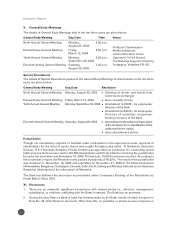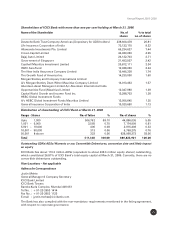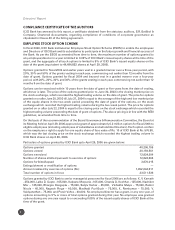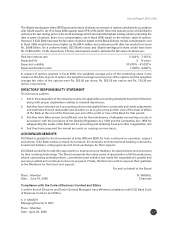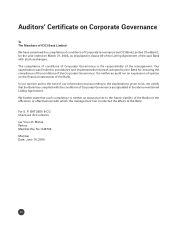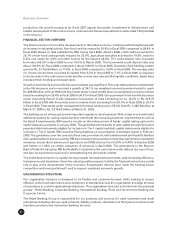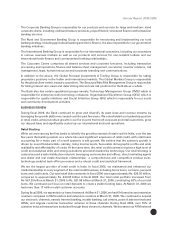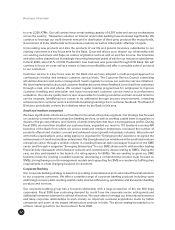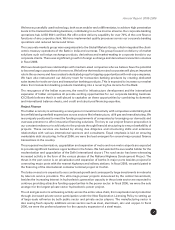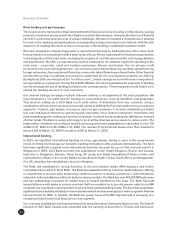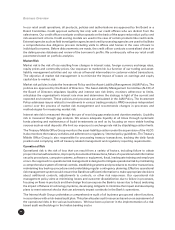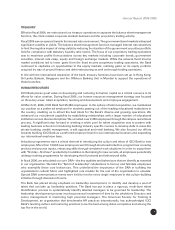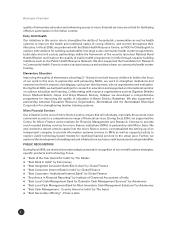ICICI Bank 2006 Annual Report Download - page 31
Download and view the complete annual report
Please find page 31 of the 2006 ICICI Bank annual report below. You can navigate through the pages in the report by either clicking on the pages listed below, or by using the keyword search tool below to find specific information within the annual report.
30
Business Overview
production, the growth prospects for fiscal 2007 appear favourable. Investment in infrastructure and
holistic development of the rural economy continue to be the key imperatives to realise India’s full potential
in the long run.
FINANCIAL SECTOR OVERVIEW
The financial sector mirrored the developments in the Indian economy. Credit growth strengthened with
an increase in industrial activity. Non-food credit increased by 30.8% in fiscal 2006 compared to 28.8% in
fiscal 2005. Based on data published by RBI, during April 2005-January 2006, retail credit accounted for
26.7% of non-food credit growth, industry for 25.9%, agriculture and allied activities for 10.9%, trade for
5.4%, real estate for 4.4% and other sectors for the balance 22.0%. The credit-deposit ratio increased
from about 62.0% in April 2005 to over 70.0% in March 2006. The incremental credit-deposit ratio was
about 102.0% for fiscal 2006 compared to about 108.0% for fiscal 2005. Deposits of the banking system
grew by Rs. 3,176.68 billion, or 17.6%, in fiscal 2006 compared to 13.8% in fiscal 2005. The average yield
on 10-year Government securities increased from 6.2% in fiscal 2005 to 7.1% in fiscal 2006. In response
to the increase in the cash reserve ratio and the reverse repo rate and the liquidity conditions, banks have
increased their lending and deposit rates.
Growth in both the life and non-life insurance markets was significant. First year retail premium underwritten
in the life insurance sector recorded a growth of 34.1% (on weighted received premium basis) to reach
Rs. 209.89 billion in fiscal 2006 with the private sector’s retail market share (on weighted received premium
basis) increasing from 25.4% in fiscal 2005 to 34.2% in fiscal 2006. Gross premium in the non-life insurance
sector (excluding Export Credit Guarantee Corporation of India Limited) grew by 16.2% to Rs. 203.79
billion in fiscal 2006 with the private sector’s market share increasing from 20.3% in fiscal 2005 to 26.6%
in fiscal 2006. Total assets under management of mutual funds grew by 55.0% from Rs. 1,495.54 billion at
March 31, 2005 to Rs. 2,318.62 billion at March 31, 2006.
The banking sector witnessed several important regulatory developments. With a view to provide banks
additional options for raising capital funds to meet both the increasing business requirements as well as
the Basel II requirements, RBI issued a circular on the enhancement of banks’ capital raising options for
capital adequacy purposes in January 2006. The guidelines permit banks to raise capital through innovative
perpetual debt instruments eligible for inclusion in Tier-1 capital and debt capital instruments eligible for
inclusion in Tier-2 capital. RBI issued its final guidelines on securitisation of standard assets in February
2006. The guidelines cover the concept of true sale, provision of credit enhancement and liquidity facilities
and capital treatment and accounting. RBI also increased the general provisioning requirement on standard
advances, except direct advances to agriculture and SME sectors, from 0.25% to 0.40% in October 2005
and further to 1.00% on certain categories of advances in April 2006. The amendment to the Reserve
Bank of India Act has given RBI the flexibility to determine the cash reserve ratio without any cap or floor,
and also incorporates provisions for strengthening the derivatives market.
The Indian financial sector is rapidly moving towards international benchmarks, with increasing efficiency,
transparency and dynamism. Given the robust growth prospects in India, the financial sector has a crucial
role to play in the development of the economy. Broad-based reforms have made the banking sector
competitive and have positioned it well to support sustained economic growth.
ORGANISATION STRUCTURE
Our organisation structure is designed to be flexible and customer-focused, while seeking to ensure
effective control and supervision and consistency in standards across the organisation and align all areas
of operations to overall organisational objectives. The organisation structure is divided into five principal
groups – Retail Banking, Corporate Banking, International Banking, Rural and Government Banking and
Corporate Centre.
The Retail Banking Group is responsible for our products and services for retail customers and small
enterprises including various credit products, liability products, distribution of third party investment and
insurance products and transaction banking services.


